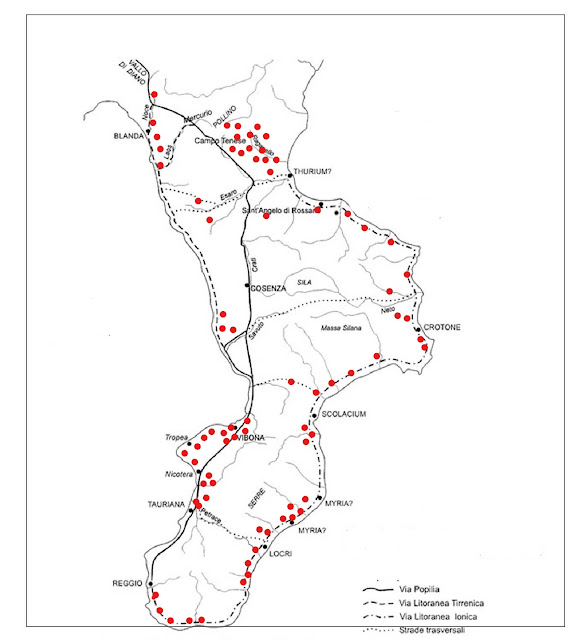NORMAN KNIGHTS in CALABRIA
Short Story - The Normans descended from Vikings, was a north European people and knowed as skilled navigators, left their land in search of fortune and booty.
To the early IX century A.D. from Scandinavia they arrived and looted the Britannic Islands, also creating communities, sequentely between IX-X century they settled in the north of France, precisely in Normandy.
Sanctuary of San Michele
Sanctuary of St Michele sul Gargano seen from above
(foto by Matteo Nuziello)
Shortily afterwards (1018) they were at the side of Melo of Bari (important rich longobard) to fight the Byzantine from Puglia, but the battle finished without success so the Drengot Brothers and their troops retreated in Campania.Sanctuary of St Michele sul Gargano seen from above
(foto by Matteo Nuziello)
The Normans were known as efficient and fast warriors, so, they were contacted by the Duke of Naples Sergio IV to help him against the Saracens and for other Lords of the nearby cities. After repeated successes on the battlefield in 1029 he granted the byzantinian fortress, called Aversa.
The Norman rise....
Rainulf Drengot transformed the previous Byzantine fortress of Aversa in a thriving city, and chose it as the power centre of the first Norman county on italian territory, becoming a reference point for other Norman groups, that from France arrived in southern Italy.
Altavilla brothers....
map of first stages of Normans (DRENGOT) in south Italy: in blu sanctuary San Michele sul Gargano (Puglia), in red Bari (Puglia), in green Ariano Irpino (Campania), in light green Naples (Campania) and finally in purple Aversa (Campania).
Altavilla brothers....
In 1035 on Italian territory appared the Altavilla brothers guided by leaders Guglielmo, Drogone and Umfredo, to be known as good warriors they were contacted of the Lombard Prince of Salerno Guimario IV.
The Prince Guimario for the good military services received by Guglielmo and Drogone offer as a gift a piece of territory in Basilicata, with the city of Melfi as seat of power, here Guglielmo in the 1043 a.D. was appointed supreme leader of the Normans and then Count.
In the 1046 Guglielmo died and his successor was the brother Drogone.
In 1048 Drogone sent his younger brother Roberto called the Guiscardo in Calabria, to annex it to their kingdom.
Roberto arrived in plain of Sibari with a militia, where there was a previous small longobard fortress called Scribla (builted in the 1040 a.C.), in a short time he built a castle to house a garrison military.
The site of Scribla castle was most important because controlled the major road routes between Calabria, Basilicata and Puglia, but a few years later Roberto and his military troops moved in south (geographic figure below).
After having abandoned the fortress of Scribla, Roberto chosed a new site to install his new headquarters called San Marco Argentano, here he had built a large fortress (so-called motta), useful to conquer the neighboring territories (figures below).
But let's step back - In the battle of Civitate (1053) Roberto promised to the Pope Leone IX to latinize southern Italy and the Calabria, to legitimate the Normans.
Note: cathedral of Gerace will be the prototype of the future norman cathedrals in Sicily.
The Prince Guimario for the good military services received by Guglielmo and Drogone offer as a gift a piece of territory in Basilicata, with the city of Melfi as seat of power, here Guglielmo in the 1043 a.D. was appointed supreme leader of the Normans and then Count.
In the 1046 Guglielmo died and his successor was the brother Drogone.
In 1048 Drogone sent his younger brother Roberto called the Guiscardo in Calabria, to annex it to their kingdom.
Roberto d'Altavilla (called Guiscard)
Roberto arrived in plain of Sibari with a militia, where there was a previous small longobard fortress called Scribla (builted in the 1040 a.C.), in a short time he built a castle to house a garrison military.
The site of Scribla castle was most important because controlled the major road routes between Calabria, Basilicata and Puglia, but a few years later Roberto and his military troops moved in south (geographic figure below).
great plain of Sibari
in blu SCRIBLA and punctuated in black the routes roads; in red San Marco Argentano
SCRIBLA - some remains of the walls
in this map show some important cities (ALTAVILLA) : in blu Melfi, in red Scribla (first norman castle in Calabria), in green San Marco Argentano, in purple Cosenza, in brown Squillace, in Pink Mileto and in yellow Reggio Calabria.
NOTE: the Calabria with the arrival of the Normans was still a byzantin province and greek-byzantine cult was alive.
After having conquered the Calabria (1060), the Normans respected the Orthodox clergy, but at the same time they built several Benedictine abbeys and great cathedrals.
After having conquered the Calabria (1060), the Normans respected the Orthodox clergy, but at the same time they built several Benedictine abbeys and great cathedrals.
But let's step back - In the battle of Civitate (1053) Roberto promised to the Pope Leone IX to latinize southern Italy and the Calabria, to legitimate the Normans.
in the figure above the position of the most important Benedictine Abbeys, located on crucial nodes for communication routes and for relation with the territory around.
Abbey of Santa Maria della Roccella 1090 a.D.
Abbey St. Maria della Matina near San Marco Argentano
The most ancient norman cathedral remained intact today in Calabria is that of Gerace, dated to 1080 in Romanesque style and distributed in three naves (figure below).
Note: cathedral of Gerace will be the prototype of the future norman cathedrals in Sicily.
Dott. Giuseppe Lombardo
























Commenti
Posta un commento